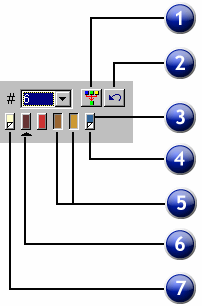The Color Tracing converts a color bitmap into colored paths. The color trace process involves two steps. The first is Posterizing, which reduces the number of colors. Then the posterized image is traced into objects of different colors.
Original bitmap |
Paths created in color tracing |
In the DesignCentral - Color Trace and Autotrace tabs, adjust the following parameters:
Posterize Bitmap |
When checked, the posterized bitmap will replace the original bitmap. |
Edge Filter |
Determines how aggressively the application removes noise from the bitmap when posterizing. When None is selected, no noise will be removed. Most removes the maximum amount of noise. |
Number of Posterized Colors |
Controls the number of colors the program will use to posterize the bitmap. If there are several shades of a given color in the bitmap, specify one or more colors beyond the actual number needed to ensure the correct colors are retained. |
Posterized Color Bars |
Appear after selecting part or all of a bitmap using a bounding box or Ctrl+click (Command in Macintosh). The number of color bars is determined by the value entered in the Number of Posterized Colors field. The active color is indicated by a black triangle below the color bar.
|
Merge into Active |
Merges the selected color into the active color. |
Undo |
Undoes the last merge operation. |

1. Merge into active |
2. Undo |
3. Color Palette |
4. Toggled Off Color |
5. Selected Colors |
6. Active Color |
7. Background Color |
|
While color tracing an image, you can specify the number of colors that will be in the Number of Posterized Colors list.
If a Background color was found, it will be placed on the far left side of the color palette. The background color will not be traced, as indicated by the folded corner.
Traced parts of the bitmap with an Untraced color will not be displayed in the preview and will not be traced. You can skip any color in the untraced color by Shift-clicking it.
The color with a triangle underneath is the Active color. The active color is used when merging colors. To make one color active, click the space underneath the color.
You can select colors by clicking them. To deselect the color, click again. You can select multiple colors. Selecting an invisible color will make it visible.
When you have two or more colors that you want to trace with the same color, you can merge them.